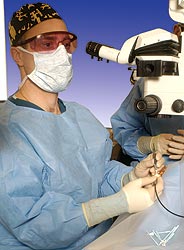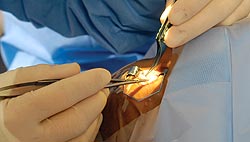ECP emerging as viable option for difficult pediatric glaucoma cases
Cost, time required to learn the technique and patients’ reliance on medications are possible obstacles to widespread acceptance.
 David A. Plager |
Endoscopic cyclophotocoagulation has been shown to have an increasingly valuable place in the management of difficult pediatric glaucoma cases, according to two clinicians who spoke with Ocular Surgery News about their experience using the modality on children.
Used primarily for treating secondary glaucoma, endoscopic cyclophotocoagulation (ECP) involves inserting a small video probe, manufactured by Endo Optiks, into the eye that allows surgeons to visualize the ciliary body in real time. Precise placement of the laser beam results in a decrease in aqueous fluid and a lower IOP, proponents of the procedure maintain.
“The sort of revolutionary thing about this endolaser treatment is that you are not treating through the outside wall of the eye blindly, so to speak, but instead this is an elegant device that involves putting the probe into the eye,” David A. Plager, MD, told OSN in a telephone interview.
“I liken it to the differences between when the military talks about using ‘smart bombs’ vs. the more conventional destructive bombs,” he said. “With [conventional bombs] … you may wipe out what you are trying to wipe out, but there is a lot of collateral damage.”
Less damaging than cyclocryotherapy
Studies have demonstrated that ECP is less damaging to surrounding tissue than cyclocryotherapy, the most commonly used method for cyclodestruction. In that procedure, a probe applied to the exterior of the eye freezes the ciliary body. Although effective at decreasing fluid, cyclocryotherapy has been found to cause phthisis and retinal detachments in some patients.
“[In] patients who have had cyclocryotherapy, the next day their eyes looked inflamed,” OSN Pediatrics/Strabismus Section Member Scott E. Olitsky, MD, said. “ECP patients have very little discomfort. In ECP patients, there is little inflammation.”
Long-term data have established the safety of the procedure. Success rates have been reported ranging from 43% to 50%. Although those numbers could be improved with aggressive treatment, more children could become phthisical.
“We are willing to accept a lower success rate by being a little less aggressive with the treatment, knowing that you could always go back and treat more months and years later, but you can’t go back and not treat,” Dr. Plager said. “So you have to take those success figures in the context of what the complication rate is and what the overtreatment rate is.”
Dr. Plager performed ECP procedures sparingly until he became convinced of its low complication rates and reasonable chance for success. One of the first ECP procedures he performed was on a 2-year-old aphakic glaucoma patient. The patient, now 15 years old, received just one treatment and has maintained excellent results.
“We have been following him for 13 years now, and he has remained completely controlled with good pressures and no medication. He has excellent vision. Not everybody has that result, but this one was very gratifying. I think that we probably would not have achieved this with any other kind of glaucoma treatment without the long-term risk of infection,” Dr. Plager said.
The procedure
Surgeons should have knowledge of angle anatomy before attempting ECP on children because the endoscope may not be effective in closed-angle glaucoma, Dr. Olitsky said.
“If significant angle closure is present, you’d probably have to treat a very large portion of the eye in order to decrease aqueous production enough to lower IOP. These are the patients I worry about,” he said. “I think the best patient to treat is the patient where the glaucoma develops sometime after the cataract extraction. It might be 1 or 2 years but sometime afterward because those angles are at least partially open. They have fairly good outflow but just not good enough. Those patients respond well to minor decreases in [aqueous] production.”
Dr. Olitsky, who has operated on aphakic infants as young as 6 months old, explained how he performs ECP.
“I usually use a small scleral tunnel,” he said. “I don’t generally use a clear corneal approach because the probe is a fairly good size and needs to be rotated in order to treat the ciliary processes. Then I usually look at the angle if the cornea is too cloudy to be seen otherwise. Then take a look at the ciliary processes with a curved probe. I’ve switched to using a curved probe in all of my cases. You can treat a good portion of the eye, somewhere between 180° and 270°, by angling the probe one way and then the other.”
 |
 Scott E.
Olitsky, MD, shown at the left performing ECP. Close-up view above. Scott E.
Olitsky, MD, shown at the left performing ECP. Close-up view above.
Images: Created by University of
Missouri Kansas City – School of Medicine; Office of Educational
Resources, Panorama Summer 2005; Creative direction and digital image
manipulation by Suzanne M. Gauch; Digital photography by John
Carmody |
Dr. Olitsky sometimes uses a tube shunt as an option because the device works more effectively in patients with closed-angle glaucoma.
“For me, ECP is my primary surgical treatment for aphakic glaucoma. … There are times when you put a tube shunt in and the pressure is not low enough. Now that you have increased outflow, you can decrease production or vice versa. You can do ECP first and if the pressure is still not low enough, you can put a tube shunt in. So I think there is a role for both of these procedures to be done if needed,” he said.
Dr. Plager noted that one of the benefits he sees in performing ECP in children is the fact that the conjunctiva is largely unaffected by the procedure.
“That is an advantage, especially later on when these kids are older. If they need some sort of outflow surgery, the conjunctiva has not been violated with this,” he said.
Learning curve
Like many procedures, there is a steep learning curve with ECP. Surgeons must first become familiar with the technique and its impact on the ciliary processes, Dr. Plager said.
“It helps to practice this a few times on practice eyes or animal eyes, just to get the feel of it, but it is a skill that can be learned quite rapidly,” he said. “It can be done in aphakic eyes where there is no lens, but you can also do it in certain phakic eyes. It is possible to do a full endolaser treatment without causing a cataract. The rate of cataract formation in phakic eyes has been extremely low.”
According to Dr. Olitsky, the biggest obstacle in performing ECP is “soft” eyes that have had cataracts removed along with a vitrectomy. He said manipulating the eye when it is soft could be difficult for first-time users.
Patients who have had setons or filters implanted may experience lifelong risks for endophthalmitis if they develop conjunctivitis or a serious eye infection, Dr. Plager said.
“There is nothing more disheartening than having a beautifully functioning seton or filter for a year, 2 years or more,” he said. “Then the child comes in out of the blue with endophthalmitis and loses the eye. When this endolaser works and the pressure has been controlled, you do not have any of that long-term risk of infection. That is one advantage to using this, especially in kids, all of whom have a lot of years ahead of them.”
Another potential drawback is that patients must continue to rely on glaucoma medications.
“In general, cyclodestructive procedures tend to have somewhat of a bad reputation because they are usually used late in the course of treatment,” Dr. Olitsky said. “Many of the bad things you see with cyclodestructive procedures might be happening because these are end-stage eyes and not the procedure itself. Of course, we don’t know the long-term outcome for these eyes. If you’re decreasing a significant amount of aqueous production in a 2-year old, we don’t know what’s going to happen to that eye 80 years from now.”
Cost is a factor
Dr. Olitsky said ECP may remain out of reach for many pediatric ophthalmologists because of the high cost of the laser and the relative newness of the technology. Because a practice may only average one ECP procedure every month or two, he said most surgical facilities cannot afford the added cost.
“In adult surgeries, a center may very well have one, but it’s tough to treat a 6- or 12-month child in these surgery centers,” he said. “I think it’s more about the ability to get the laser in a place where you can treat children.”
“It involves an investment in the equipment, and it involves an investment in time in learning how to do it,” Dr. Plager agreed. “I think a lot of people were sitting back waiting to see if this was something that works and does not present a whole new set of complications. I think with 13 years follow-up now, we have a good idea that this definitely has a place in the treatment.”
For more information:
- David A. Plager, MD, is professor of ophthalmology, director, pediatric ophthalmology and adult strabismus service at Indiana University School of Medicine. He can be reached at 702 Rotary Circle, Indianapolis, IN 46202; 317-274-1214; fax: 317-274-1111; e-mail: dplager@iupui.edu. Dr. Plager has no direct financial interest in the products discussed in this article, nor is he a paid consultant for any companies mentioned.
- Scott E. Olitsky, MD, can be reached at Children’s Mercy Hospital, 2401 Gillham Road, Kansas City, MO 64108; 816-234-3000; fax; 816-346-1375; e-mail: seolitsky@cmh.edu. Dr. Olitsky has no direct financial interest in the products discussed in this article, nor is he a paid consultant for any companies mentioned.
- Endo Optiks can be reached at 39 Sycamore Ave., Little Silver, NJ 07739; 732-530-6762; 800-756-3636; fax: 732-530-5344; Web site: www.endo-optiks.com.
- John Misiano is an OSN Staff Writer who covers all aspects of ophthalmology.
